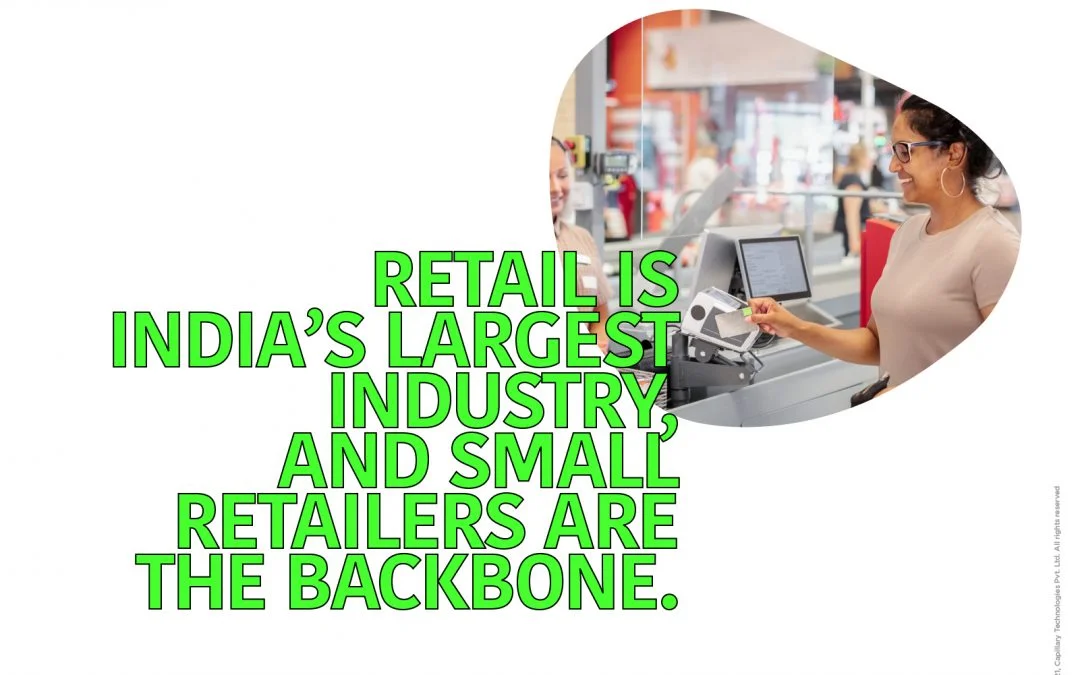- Design industry shaping loyalty programs
- Integrate easily and go live quicker
- Deliver hyper-personalized consumer experiences
Blue Rewards from Al Futtaim Group Shares Loyalty Success Stories and Evolution. Watch Podcast >
Capillary Announces 2nd Annual Captivate 2025 Summit: Transforming Loyalty Management with New AI Tech Read more >

At the heart of the Indian retail tale, the true star even through the pandemic, is the friendly neighbourhood ‘kirana’ store. This makes sense when you realize that the grocery sector accounts for half of India’s retail consumption, and kiranas (which are small- to mid- sized conventional stores, often family-run) account for about 90 percent of the country’s roughly $500 billion food and grocery market.
In our previous blogs, we have written about the impact of COVID-19 on global and regional retail industries. The pandemic spurred the adoption of online retailing (India’s ecommerce market is estimated to be growing at a 30 percent compound annual growth rate over the next five years), but the pandemic also led to a renewed trust in local stores, with a surge in new consumers visiting local stores both in metros and non-metros. In fact, in contrast to the fashion industry, the food and grocery retailers fared relatively well during the pandemic, and even reverted to pre-COVID-19 level sales and profits in the third quarter of 2020-21. This is because grocery retailers were crucial during the COVID-19-induced lockdown. Even though the lockdown and coronavirus mitigation protocols forced more consumers to shop online, the e-commerce industry was hard hit as it was not deemed an essential service (and could not deliver goods) and for other reasons like last-mile logistics. The retail sector incurred massive losses of about INR 5.50 lakh crore (approximately US$75 billion), and at least 20 percent of Indian retailers shut their businesses due to COVID-19. In this blog, we outline why small retailers should digitize their sales and business operations to reduce similar vulnerabilities.
According to the United Nations Conference on Trade and Development’s Business-To-Consumer E Commerce Index 2019, India ranks 73 out of 152 countries on its readiness to support online shopping. Increasing internet penetration and smartphone and social media use have driven the growth of e-commerce in India. In fact, ecommerce has become increasingly popular even in Tier II and Tier III cities, due to services like cash-on-delivery, free home delivery, deeper discounts, flexible payment options, buy-back policies, and a wider offer of products.
Ecommerce has made massive leaps in India’s retail sector: 220 million people are expected to shop online by 2025, and the industry is predicted to grow to INR 13,97,800 crore (US$200 billion) by 2027. The Grocery and Fashion apparel sectors are poised to drive this growth, triggered by the expanding internet and smartphone penetration. Given these insights, it becomes imperative for kirana stores to take steps to offer an ecommerce option for those who choose it, or risk losing out on sales. Many kiranas agree— as many as 58 percent of traders surveyed in metro cities and 46 percent in the non-metros are convinced that they need to digitize due to Covid-19.
Although online food and grocery retail has made headway in the country, it still counts for just 0.2 percent of all sales (according to consulting firm Redseer). Of India’s over 12 million local retail shops, only 15,000 have digitised their operations with mobile apps. Being heralded as the way forward to bridge this gap is the ‘phygital model’. It can be viewed as an integration of digital technology (digital) with personal interactions with consumers (physical), to bridge the gulf between the two. It combines the mileage of human service and trust with the efficiency and power of digital technology. An effective phygital retail strategy ideally focuses on three I’s – immediacy, immersion, and interaction.
The evolution from ‘bricks vs. clicks’ to ‘bricks and clicks’ will see the mix of traditional stores, modern brick-and-mortar stores and online channels, with each complementing the other. Developing such symbiotic partnerships will enable the growth of small and medium stores by widening the customer base and marketing potential. Meanwhile, customers will be able to choose from a mix of shopping modes. Several such partnerships are currently being explored, such as:
As restrictions start easing, Indian retail stores can advertise their offline business through platforms like Facebook and Instagram. In June 2020, Instagram hit one billion monthly users—more than an eighth of the world’s population. That said, about two million advertisers use Instagram every month—this is still a very small percentage of one billion. This shows there is still an abundance of opportunity to leverage social media channels as a platform to sell your brand, and draw larger audiences.
For large brands with a significant audience, taking a direct sales approach through social media posts may work well, as they are more likely to have already established trust, and have a loyal customer base. For brands lacking a sizable audience of followers, one method is to buy ad space on social media networks instead, which can help businesses to target individuals who are more likely to be interested in their product, rather than mass marketing to everyone. Small businesses can also have the advantage of offering a personal touch while responding to followers. Responsiveness is the most sought-after quality in a business social media account (according to a survey by Sprout Social), and it’s the one thing that’s most likely to lead to sales in all demographics of online customers.
About 80 percent of India’s retail stores continue to be cash-intensive and operate in the informal economy. Cash is the preferred mode of payment in kirana stores due to its ease of use, familiarity, and for the sense of control it provides. Studies to uncover the reason for merchants’ slow adoption show that trust was a major influencing factor, along with factors like usefulness, trustworthiness, and non-fraudulent and error-free transactions. In some instances, kirana owners’ attitude towards digital technologies is strongly influenced by the fear of tax implications and additional costs levied by banks on digital transactions, as well as the potential investment needed to use the technologies (such as to buy or hire POS devices).
There has been a concerted effort from the public sector to push ecommerce and digital payments across India. A few of their programmes aimed at digitising small retailers include Aadhaar-based biometric systems, the Pradhan Mantri Jan-Dhan Yojana (PMJDY), the government-promoted Bharat Interface for Money (BHIM) app, Bharat QR code, RuPay cards and the ‘Digital India’ programme. Additionally, private sector initiatives have complemented these efforts to promote digitisation.
However, in the past year, retail digital payments have seen huge growth as more people gravitated towards digital modes of transaction owing to fear of contracting the virus and convenience. Retail payment platforms such as Unified Payments Interface (UPI), Immediate Payment Service (IMPS), and National Automated Clearing House (NACH) saw a near doubling of both transaction volume from 12.5 billion to 22.3 billion, and value from Rs 21.3 trillion to Rs 41 trillion between FY2020 and 2021. To increase digitization even further, the security of India’s overall digital architecture will need to be fortified to improve trust in digital technologies among merchants and customers.
Retail is India’s largest industry, accounting for over 10 percent of the country’s GDP and 8 percent of employment. Local convenience stores still account for the majority of retail transactions, making small retailers the backbone of the Indian economy. It is of paramount importance to support digitization efforts using transparent policies and platforms that benefit small- and mid- sized local retailers, hence giving more power to them and the local communities they support.

May 20, 2020 | 4 Min Read
We had previously covered how retailers can successfully dea

July 5, 2021 | 4 Min Read
The story began in 2006 when the Indian retail sector was in

June 17, 2021 | 4 Min Read
At the heart of the Indian retail tale, the true star even t